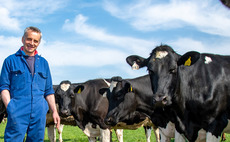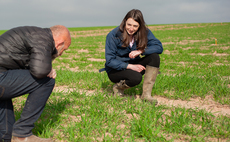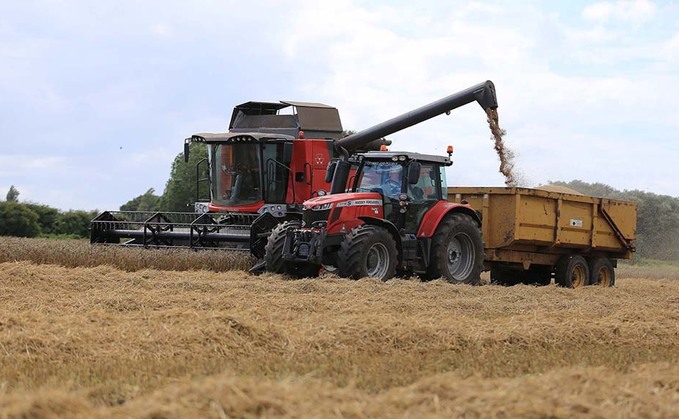
In recent years, attention to Massey Ferguson's combines has been diverted at the range topping Ideal machines, however, its smaller ranges are still proving invaluable for many farmers. Alex Heath speaks to a Beta user of six years to find out how it is performing.
For mixed farmer David Wilkinson, preserving the integrity of his soil while making the most of catchy opportunities to harvest on the west coast of England, near Southport, is a priority, and as such, a light combine is a must.
The harvesting tool of choice for Mr Wilkinson is a Massey Ferguson Beta 7360, the smallest combine in the manufacturer's two model Beta range.
"We farm on very fluffy, soft peat, typical of the area," says Mr Wilkinson. "While it grows good crops, the management of the soils is tricky. It does not react well to heavy machinery, compacting easily."
Arriving on the farm as a demonstration at the end of harvest in 2014, Mr Wilkinson was impressed with its light touch, consequently purchasing the machine and harvesting the last of that year's spring beans.
Having run an MF 32 for 15 years previously with little trouble, he likes the design of the Laverda-inspired machines. "The 32 served us well, the only major problem being over winter in 2011 where the engine block cracked in the cold, as did the radiator. When the radiator thawed out, being placed above the engine, all the water drained into the block, writing it off.
"We had an Activa for the season from dealer Clarke and Pulman, again proving a light machine suited our land, but we needed more capacity than the Activa could offer."
Harvesting in excess of 280 hectares of crops last year, 242ha of which are the farm's own, made up of 26ha winter wheat, 81ha of spring wheat, 36ha of oilseed rape and 121ha of spring barley, the Beta combine has a busy schedule.
The demo machine came with a 6.1 metre PowerFlow header, however, due to the soft nature of the soils, Mr Wilkinson felt it was too heavy on the front of the combine. "The soil will bulldoze easily and before you realise you are dropping in, a load of soil has gone through the combine. For this reason, we went for a narrower, lighter header."
Instead, the farm opted for the manufacturer's 5.5m wide FreeFlow header, which Mr Wilkinson reports cuts and feeds well.
Being narrower has its advantages in terms of weight, but it is obviously not bringing as much crop into the combine. "I would sooner keep forward speed up and max out the combine that way than trundling up and down with a wider header," says Mr Wilkinson.
Harvesting speed is typically about the 5kph mark, with 2.1 to 2.4 hectares per hour threshed.
A major difference over the previous machine is the inclusion of an extra threshing drum. The first had eight ballasted rasp bars creating more inertia, while the second has 12 with a wrap angle of 120-degrees. "When the combine arrived, it was visibly narrower than the 32," Mr Wilkinson says. "We put a tape across the sieve area, and it was about an inch narrower, which raised some concerns. However, that extra threshing drum makes a massive difference and the sample is better coming out the Beta than the old machine."
Mr Wilkinson says although he does not harvest any barley for crimping anymore, the combine will still tackle green and damp crops with little compliant. "She will eat crop, and the five walkers produce a lovely sample of straw."
While wheat and OSR is sold off the farm, the barley and straw are used in the cattle unit, comprising 550-head, bought in as two week old calves before being sold through a variety of outlets. Black and white bulls are finished at 12 to 14 months through a Buitelaar contract; steers go to Woodhead Bros at 18 to 24 months and natives are sent to Dunbia. All muck is returned to the land. "We have recently taken on a block of land," says Mr Wilkinson. "The difference between our land that has had regular muck applications and the new land that has not had any on for a long time is noticable."
Further improving the combine's sympathetic tread is the pair of 800/65R32 Trelleborg tyres fitted to the drive wheels. Mr Wilkinson says the balance of the combine is very good with the majority of its weight placed over the drive axle, meaning the 540mm-wide rear tyres leave a very slight imprint.
With up to 9,000-litres of grain on board, unloading speed is up to 105 litres/second but this is highly dependent on grain moisture, says Mr Wilkinson. "Normally we would unload within a couple hundred metres but with moister grain, it can be double that, but we cannot wait until the crop is 100 per cent fit - if needs must, we will dry it."
As for reliability, Mr Wilkinson says only two small incidents have happened in the six years of ownership. "Being an early model, the extractor fan for the radiator collapsed. This is now a problem that has been remedied on later models. I did not even realise it had happened until the end of the season, but it was duly replaced and caused no lasting damage," he says.
The combine is always main dealer serviced before harvest commences. "Just as we started one year, a chain driving one of the rotors in the feeder house snapped, but being behind a guard and on the other side of the housing to most of the other components, it was neglected, but we now know to check it."
Mr Wilkinson reports the 7.4-litre Agco Power engine has been reliable and economical in its performance. With 306hp on tap it is plenty powerful enough for the farm, being flat. "I can drive the combine to the engine limit, safe in the knowledge the combine is extracting all the grain and putting it in the tank," says Mr Wilkinson.
He also appreciates the cab fitted to the machine. "It is a lovely place to spend the day," he says. "It is quiet and spacious with just the right amount of technology on board. It has automatic header height and reel speed controls which are nice to have features.
"When it first came, the electro-hydraulic joystick took some getting used, after coming off a fully mechanical assembly. It does not require anywhere near the amount of force to control it, with much more subtle movements leading to increased precision. Everything falls well to hand, also."

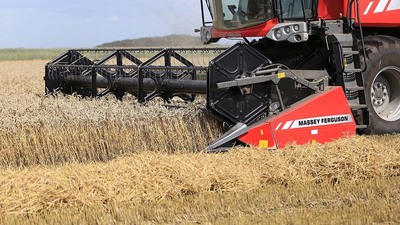
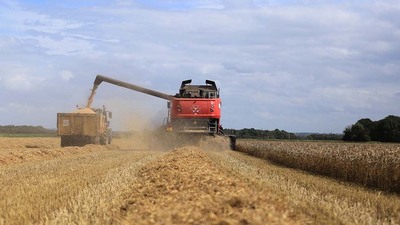
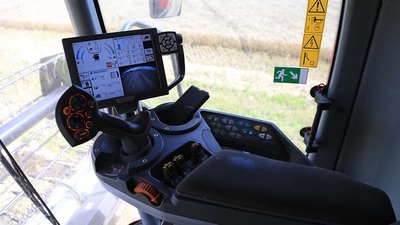
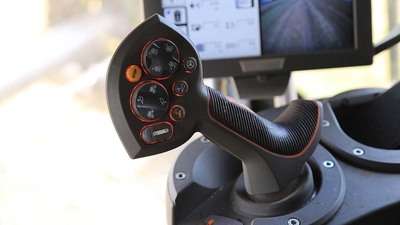
Verdict
Mr Wilkinson says the Massey Ferguson Beta 7360 suits the farm, treating the soft land well and providing enough capacity to harvest the farm's and a couple of other land owners' crops in a catchy season. Opting for the narrower 5.5 metre header has not hampered the machine as it can be driven at a higher forward speed to achieve output, while also preserving the fertile peat. Ultimately, the reliability of his old combine, the dealer backup and familiarity of the machine swayed Mr Wilkinson's decision, and one that is so far paying off.













